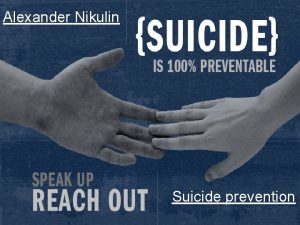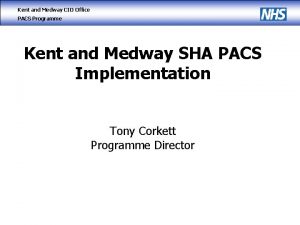Kent and Medway STP Suicide prevention overarching driver



- Slides: 3

Kent and Medway STP Suicide prevention overarching driver diagram and theories of change 2018/19 Tim Woodhouse, Suicide Prevention Specialist tim. woodhouse@kent. gov. uk Transforming health and social care in Kent and Medway is a partnership of all the NHS organisations in Kent and Medway, Kent County Council and Medway Council. We are working together to develop and deliver the Sustainability and Transformation Plan for our area.

AIM In order to; Reduce suicide rates in Kent and Medway by 10% by 2021 PRIMARY DRIVERS We need to reduce suicides amongst; SECONDARY DRIVERS We will do this by; 1. People not known to primary or secondary MH services (including high risk groups: middle aged men, CYP and students) 1. Raising awareness of available support through social marketing 2. People not known to secondary MH services but known to primary care 5. Improving awareness and knowledge of appropriate interventions amongst primary care teams 3. People known to secondary MH services 2. Training over 1000 individuals in suicide awareness & prevention 3. Reducing access to means 4. Understanding more about why people want to die 6. Better identification and support for people with previous suicide attempts 7. Strengthening services at three high risk points CHANGE IDEAS Examples of how this will be delivered include; Release the pressure Commission a package of Suicide Awareness and Prevention training Review high risk locations Suicide Safer Universities Project Coroners’ Audit GP training pilots (including bespoke training for receptionists) “Quality Lab” workshop about primary care innovation Enhanced 7 day follow up after discharge from psychiatric ward Strengthened support for patients discharged from CMHT 8. Developing a Zero-suicide plan for in-patient settings Enhanced follow up & support for people presenting with self harm at A+E 9. Increasing knowledge and skills amongst secondary MH staff Mandatory Suicide Prevention training for all KMPT staff

3 Known and Known Unknowns Theory 1 Theory 2 Theory 3 Theory 4 Theory 5 Issue Shame & Stigma : Men don’t reach out when desperate Not Listening: People do reach out in primary care and to some people BUT hit barriers very fast Desperation: people get to crisis quickly and don’t know what to do (YP) & nor do services Not looking: People are an accident waiting to happen and don’t know their signs and services are not looking. No service is right: The current services are not right for the population- what has worked. Suggested response Help Line and Awareness to Men Long term Follow-up of people with previous suicide attempts. Addressing medication, case management, and Substance Misuse. Training and Awareness of staff Training and Awareness of Public Training and Awareness Services not joined up At risk groups / people not identified Flagging systems – not available Urgent Care systems don’t join up to rehab and recovery. People fall through the net New Design of service / peer groups/ Time to Change / Empowerment models/ public awareness Expected timeframe Medium to Long Term Short Term Med Term/ Short Term? Short term ? Results Increase awareness Depression pathway, MDT Trained Staff Improve pathways and serious incident A new conversation – e. g. Coronation Street





